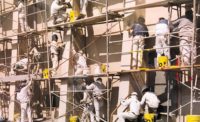Take it off, take it all off. These words are typically not heard on a construction site, but increasingly, we hear this phrase coming out of the mouths of our industry experts. When I say industry experts, I’m talking about our independent cladding experts and when they say take it all off, they are referring to our exterior stucco and EIFS claddings.
You may recall the sensationalized attack on the EIFS claddings back around 2005 where it was a top news story, covering the poor people who had EIFS claddings on their homes. Some moisture intrusion had gotten behind the barrier EIFS and damaged some of the sheathing and framing members. The “panic” propagated by the experts, called for a complete removal of the EIFS cladding and the replacement with anything but EIFS. I say poor people because the panic brought about a misperceived notion that EIFS was inherently flawed, caused mold and therefore reduced that value of said EIFS clad home. Many homeowners were unable to sell their homes if they were clad in EIFS and in fact had their home values drop considerably. Luckily proper education and time have healed the “take it all off” mentality, or has it?
Stucco, both three coat and one coat, are a very popular residential cladding. We are in a genesis of sorts in relation to our stucco claddings where terms like “stucco-pocalypse” are whispered and groups like Angie’s List and Trulia are publishing “should you buy” and “common problems with” articles on stucco clad homes. And the final icing on the cake, the sugary slogan of “take it all off.” So, could you, would you, and should you?
The answer to this proposed set of questions is: It depends but probably not. Let me clear out the weeds.
The Breakdown
Since it is adhesively attached, EIFS can be removed and replaced with little damage to the existing structure. In most cases where moisture intrusion has occurred, only the affected areas need attention. Unless the adhesion of the entire cladding is compromised, during application the entire lamina became frozen, or the entire exterior has non-compliant mesh, there is no need to remove all of the EIFS (let the word “entire” rest in your memory).
Stucco on the other hand is physically attached to the framing members of the wall assemblies. An attachment is required every 7 inches and the component being attached is the lath. Lath can be an expanded metal, woven netting, welded wire or proprietary glass fiber, that when the stucco is applied, becomes the workhorse that keeps the stucco in place. Trims and accessories are also attached every 7 inches. This robust attachment was engineered to hold the sheer weight of the stucco cladding.
Let’s picture a three-coat stucco clad building with a moisture intrusion issue, nay, multiple intrusion occurrences. And these occurrences are on multiple elevations, not all but most, and most of the damage is at the termination points where stucco meets other objects. Furthermore, there is some intrusion at the control joint intersections. Some forensic demolition has been done and the intrusion extends a few inches or feet near these identified areas.
Also present, is some rust on the metal lath components and trims in these locations. There is degradation of the WRB and some dry rot. And finally, let’s say this damage has affected 10 percent of the building. Oh, and I forgot, it is occupied and has been for many years with no damage to any of the interior walls. Do you take it all off? This was an actual building I visited where an independent third party recommended just that, take it all off.
Is it Possible?
I admit that there were some less than stellar details where the stucco met other things and there was some cracking visible, but overall a good-looking Southwest Style building. There was no evidence of moisture intrusion on the interior walls, ergo: It was assumed that the moisture intrusion was limited to the exterior sheathing. These occurrences I viewed were of course not desirable but nonetheless, not fatal to the integrity of the building. We advised the owners that to take it all off would be a huge burden on both the building and the occupants.
What many don’t consider is the sheer force it takes to beat stucco out of its nested integration with the lath. Granted if the stucco was frozen or not wet cured and soft, it is a bit easier to bang away the cement and leave the lath intact. Of far greater importance is that when stucco is to be beaten out of its nest, extreme care needs to be taken to leave the continuous WRB intact. It is a challenge to effectively patch the WRB behind the lath left in place. At the end of the day to beat out an entire elevation of stucco, a 100 percent removal of just the stucco, is an effort in futility, a fool’s errand if you will.
This may lead you the assumption that the entire stucco cladding would then need to be removed down to the studs. Remember all of the fastening points required to install the lath components? Removed fasteners leave holes in the framing members, to which at least that many or more new holes will need to be made for the new cladding. Granted in a wood framed structure, this may not be a critical issue.
But picture a steel stud framed structure, where the screw fasteners only hold is where the threads of a screw engage the metal. Ever backed out a metal screw from a metal stud and then put the screw back in the same hole? I have and sometimes it spins out, sometimes it doesn’t. But how can one be sure they aren’t hitting an old hole or screwing right next to an old hole? Not to mention the number of holes overall in this metal structural piece.
Then of course we have to consider weight, or the sudden lack thereof, that can wreak havoc on the framed structure. Three-coat stucco weighs about 11 to 13 pounds per square foot and that framed structure has been holding that weight in place while the interior components were added and finished. To suddenly remove the weight causes the studs to move independently and this in turn puts stress on the interior finished surfaces which can cause them to exhibit their own issues like cracks and nail pops.
The Remedy
The suggested remedy to take it all off should be given as a no-other-option recommendation. One where the entire elevation was compromised, that is, the stucco itself cannot perform. To hastily recommend one to take it all off entirely, is a disservice and short-sided panic reaction. The affected area may in fact have damaged a large portion of an elevation but can be removed and replaced as a patch. Remembering that gravity is ever present, it would be highly probable that any noted moisture intrusion areas would be affected at the area of intrusion and below, not above. Yes, water can wick upward but gravities persistence and waters inherent nature to take the path of least resistance, usually dictates otherwise.
Let’s imagine a scenario where the stucco had issues and it wasn’t all taken off, and multiple patches were done and when finished looked like a patchwork of cement panels. No amount of dressing up of the patch joints would hide them and even when re-finished were visible. And suppose the color just wouldn’t match and in the end the building owner was sad. An enterprising contractor may suggest the addition of an EIFS cladding right over the repaired stucco. And then, in the end, the building owner is happy, the occupants are happy, the contractor is happy, the environment didn’t get a bunch of waste added to the dump, and the building used less energy, which reduced the contribution to global warming.









